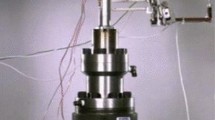Abstract
The transition of the fracture surface in notched and unnotched PMMA rods under torsional loading is investigated experimentally. The experiments show that for crack initiation from a notch, resulting in dynamic fracture propagation, as the notch depth increases, the surface transitions from a spiral fracture to a nominally flat, but faceted surface. The facets coarsen and merge as the crack grows toward the center of the rod. The resulting fracture surfaces as well as the multiple internal micro-cracks are visualized using micro CT scanning.






Similar content being viewed by others
References
Berto F, Elices M, Lazzarin P, Zappalorto M (2012) Fracture behaviour of notched round bars made of PMMA subjected to torsion at room temperature. Eng Fract Mech 90:143–160
Berto F, Cendon DA, Lazzarin P, Elices M (2013) Fracture behaviour of notched round bars made of PMMA subjected to torsion at \(-\)60 \(^{\circ }\)C. Eng Fract Mech 102:271–287
Carter BJ, Wawrzynek PA, Ingraffea AR (2000) Automated 3-D crack growth simulation. Int J Numer Methods Eng 47(1–3):229–253
Coffman VR, Sethna JP, Heber G, Liu M, Ingraffea A, Bailey NP, Barker EI (2008) A comparison of finite element and atomistic modelling of fracture. Model Simul Mater Sci Eng 16(6):065008
Cooke ML, Pollard DD (1996) Fracture propagation paths under mixed mode loading within rectangular blocks of polymethyl methacrylate. J Geophys Res 101:3387–3400
David D, Segall P, Delaney PT (1982) Formation and interpretation of dilatant echelon cracks. Geol Soc Am Bull 93(12):1291–1303
Hakim V, Karma A (2009) Laws of crack motion and phase-field models of fracture. J Mech Phys Solids 57(2):342–368
Hull D (1993) Tilting cracks: the evolution of fracture surface topology in brittle solids. Int J Fract 62(2):119–138
Knauss W (1970) An observation of crack propagation in anti-plane shear. Int J Fract 6(2):183–187
Lazarus V, Leblond J-B, Mouchrif S-E (2001a) Crack front rotation and segmentation in mixed mode I + III or I + II + III. Part I: calculation of stress intensity factors. J Mech Phys Solids 49(7):1399–1420
Lazarus V, Leblond J-B, Mouchrif S-E (2001b) Crack front rotation and segmentation in mixed mode I + III or I + II + III. Part II: comparison with experiments. J Mech Phys Solids 49(7):1421–1443
Lazarus V, Buchholz FG, Wiebesiek J, Fulland M (2008) Comparison of predictions by mode II or mode III criteria on crack front twisting in three or four point bending experiments. Int J Fract 153(2):141–151
Leblond J-B, Karma A, Lazarus V (2011) Theoretical analysis of crack front instability in mode I + III. J Mech Phys Solids 59(9):1872–1887
Lin B, Mear ME, Ravi-Chandar K (2010) Criterion for initiation of cracks under mixed-mode I + III loading. Int J Fract 165(2):175–188
Liu S, Chao YJ, Zhu X (2004) Tensile–shear transition in mixed mode I/III fracture. Int J Solids Struct 41(22–23):6147–6172
Park K, Paulino GH, Celes W, Espinha R (2012) Adaptive mesh refinement and coarsening for cohesive zone modeling of dynamic fracture. Int J Numer Methods Eng 92(1):1–35
Pham KH, Ravi-Chandar K (2014) Further examination of the criterion for crack initiation under mixed-mode I + III loading. Int J Fract 189(2):121–138
Pons AJ, Karma A (2010) Helical crack-front instability in mixed-mode fracture. Nature 464(7285):85–89
Ronsin O, Caroli C, Baumberger T (2014) Crack front echelon instability in mixed mode fracture of a strongly nonlinear elastic solid. Europhys Lett 105(3):34001
Sommer E (1969) Formation of fracture lances in glass. Eng Fract Mech 1(3):539–546
Suresh S, Tschegg EK (1987) Combined mode I-mode III fracture of fatigue-precracked alumina. J Am Ceram Soc 70(10):726–733
Tada H, Paris P, Irwin G (2000) Stress analysis of cracks handbook, 3rd edn. ASME Press, New York
Tschegg EK (1983) Mode III and mode I fatigue crack propagation behavior under torsional loading. J Mater Sci 18(6):1604–1614
Tschegg EK, Suresh S (1988) Mode III fracture of 4340 steel: effects of tempering temperature and fracture surface interference. Metall Trans A Phys Metall Mater Sci 19(12):3035–3044
Youn DH, Bobaru F (2010) Studies of dynamic crack propagation and crack branching with peridynamics. Int J Fract 162(1–2):229–244 03
Acknowledgments
This work was supported by a grant from Cornell Engineering Learning Initiatives. The use of Cornell University’s Biotechnology Resource Center (BRC) is gratefully acknowledged. The authors would like to thank Larissa-Helen Mahaga-Ajala for the surface reconstruction algorithm used to generate Fig. 6.
Author information
Authors and Affiliations
Corresponding author
Rights and permissions
About this article
Cite this article
Zehnder, A.T., Zella, N.K. Spiral to flat fracture transition for notched rods under torsional loading. Int J Fract 195, 87–92 (2015). https://doi.org/10.1007/s10704-015-0049-7
Received:
Accepted:
Published:
Issue Date:
DOI: https://doi.org/10.1007/s10704-015-0049-7




